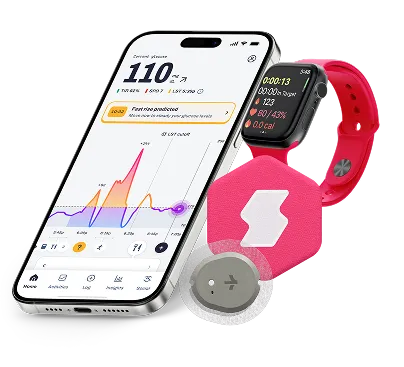Farro, a nutrient-rich ancient grain, is gaining popularity in modern diets for its unique taste and health benefits. While farro contains carbohydrates, its glycemic index is relatively low compared to other grains, making it a suitable option for individuals managing blood sugar levels.¹ Rich in fiber, vitamins, and minerals, farro provides sustained energy and may help improve digestion and overall health.
This article will explore the nuances of farro's impact on glycemic response and its potential advantages for individuals with diabetes, offering insights beyond typical comparisons with barley and other grains.
Sign up to be the first to know about special offers and exciting Signos news.
Glycemic Index Table
Based on a 100-gram serving size of cooked farro, the calculated values are as follows:
- Glycemic Index (GI): The glycemic index of farro is approximately 40, indicating a moderate impact on blood sugar levels.¹
- Carbohydrates per Serving: Farro contains approximately 28.2 grams of carbohydrates per 100-gram serving.²
- Glycemic Load (GL) per Serving: To calculate the glycemic load per serving, we use the formula: Glycemic Load = (Glycemic Index × Carbohydrates per Serving) / 100. For farro, the glycemic load per 100-gram serving is approximately 11.3 [(40 × 28.2) / 100].
The glycemic index (GI) measures how quickly a carbohydrate-containing food raises blood glucose levels. Foods with a low GI (55 or less) are digested and absorbed slowly, resulting in a gradual rise in blood sugar levels. Farro falls into this category, making it a suitable choice for individuals aiming to manage blood sugar levels.
Cooking methods can affect the glycemic index of farro; for example, cooking it al dente may result in a lower GI compared to fully cooked farro. These nuances are important to consider when incorporating farro into a diabetic-friendly diet plan.

Nutritional Facts
Farro is a nutrient-dense ancient grain rich in fiber, protein, and various vitamins and minerals such as magnesium, iron, and zinc. A 100-gram serving of cooked farro typically contains about 3.5 grams of fiber, 3.5 grams of protein, and provides significant amounts of essential nutrients.² Additionally, farro is naturally low in fat and cholesterol, making it a wholesome choice for those seeking a nutritious addition to their diet.
The nutritional information below is for 100 g of farro.²
Nutritional Facts

Is Farro Good for Weight Loss?
Farro can be a beneficial addition to a weight loss diet due to its high fiber content, which promotes feelings of fullness and satiety. Additionally, farro is a whole grain with a moderate glycemic index, meaning it may help regulate blood sugar levels and prevent spikes in insulin, potentially aiding in weight management efforts.¹
Its nutrient density, including vitamins, minerals, and protein, makes it a satisfying and nutritious choice for individuals seeking to control their weight. However, as with any food, portion control, and overall calorie intake remain essential factors in weight loss success.
Is Farro Good for People Living with Diabetes?
Farro can be a safe and beneficial option for individuals with diabetes when consumed in moderation as part of a balanced diet. Its moderate glycemic index and high fiber content contribute to slower digestion and steadier blood sugar levels. Incorporating whole grains like farro into the diet may help improve glycemic control, reduce the risk of cardiovascular disease, and promote overall health in individuals with diabetes.
However, it's crucial for individuals to monitor their portion sizes and carbohydrate intake, as well as consult with a healthcare provider or registered dietitian to tailor their diet plan to their specific needs and blood sugar management goals.
Better health starts here.
Sign up for tips and insights that work for you!
Allergies
Allergies to farro are rare but can occur, particularly in individuals with sensitivities to gluten, as farro contains gluten proteins. Symptoms of a farro allergy may include gastrointestinal discomfort, bloating, or skin reactions in susceptible individuals. It's essential for individuals with known gluten sensitivities or celiac disease to exercise caution and consult with a healthcare professional before consuming farro or products containing farro-derived ingredients.

References
References
- The University of Sydney. (2023, May 1). Glycemic Index – Glycemic Index Research and GI News. https://glycemicindex.com/
- USDA FoodData Central. (2023, October 26). Food Details - Farro. https://fdc.nal.usda.gov/fdc-app.html#/food-details/2659627/nutrients




.svg)
.svg)
.svg)
.svg)
.svg)
.svg)
.svg)
.svg)
